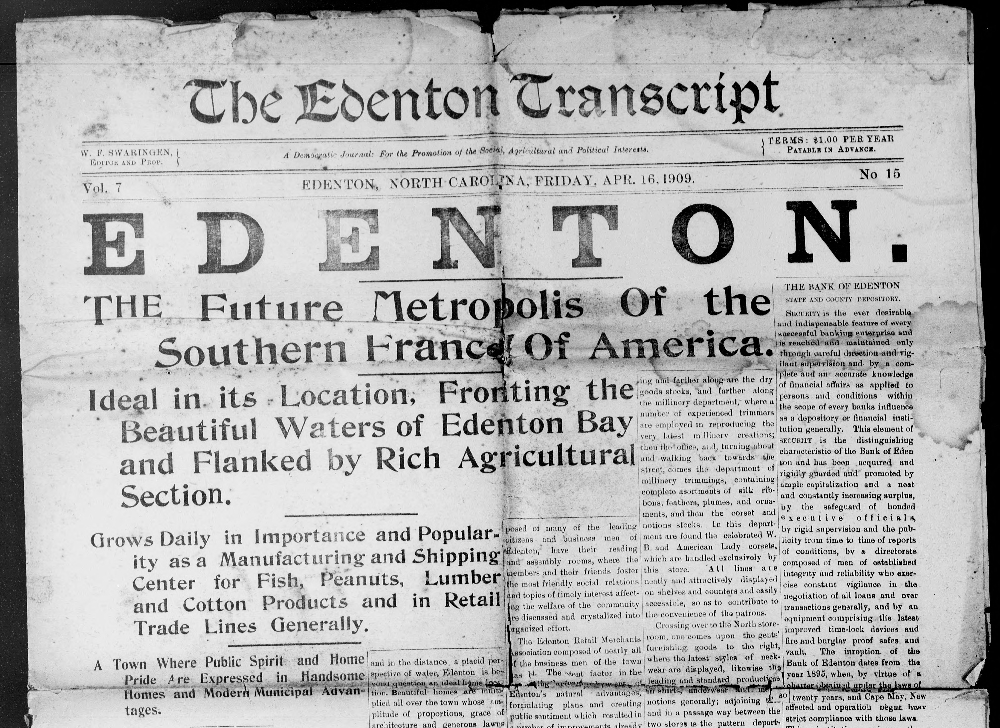We’ve just added newspaper issues from 37 titles, dating from 1819-1968, with the majority dating from the late 19th and early 20th centuries. From a variety of cities, most of these additions are only 1-5 issues per title. Thanks to the State Archives of North Carolina and its preservation of newspapers, we’re pleased to include these fill-in issues. The State Archives provided them to us as part of their newspaper microfilming workflow.
Below is a list of titles, their cities of publication, and the years from which the issues date.
- Southern Citizen, Asheboro – 1873
- The Asheboro Courier, Asheboro – 1888
- Bayboro Sentinel, Bayboro – 1902
- Beaufort Halcyon, Beaufort – 1855
- The Carteret County Telephone, Beaufort – 1882, 1884-1885
- The Weekly Record, Beaufort – 1886
- The Tobacco Plant (Durham), Durham – 1872, 1882-1883
- The Durham Daily Globe (later the Herald-Sun), Durham – 1891
- The Edenton Transcript, Edenton – 1908-1909
- The Albemarle Observer, Edenton – 1911
- The Edenton News, Edenton – 1922
- The North Carolinian, Fayetteville – 1856-1857
- Western Reporter, Franklin – 1880
- Our Farms, Franklinton – 1896
- Weekly Message (later The Olive Branch), Greensborough – 1855
- The Gold Leaf, Henderson – 1885
- The Herald of Truth, Hendersonville – 1855
- The High Point Enterprise, High Point – 1968
- The Lincoln Courier, Lincolnton – 1867
- The Visitor (paper of the Littleton Female College), Littleton – 1902
- The Littleton Dispatch, Littleton – 1928
- The Franklin Times , Louisburg – 1879
- The Robesonian, Lumberton – 1872, 1876-1877, 1880-1881
- Milton Intelligencer, Milton – 1819
- The Milton Chronicle, Milton – 1860, 1883
- The Monroe Enquirer, Monroe – 1881
- The Norlina Headlight, Norlina – 1919
- The Granville Free Lance, Oxford – 1880
- The Oxford Torchlight, Oxford – 1881
- Spirit of the Age Raleigh – 1855
- The Spy, Raleigh – 1875
- North Carolina Spectator and Western Advertiser, Rutherfordton – 1834
- The Rutherford Banner, Rutherfordton – 1888
- The Democrat, Rutherfordton – 1895
- The Sun, Rutherfordton – 1918-1919
- North Carolina Argus, Wadesboro – 1855
The State Archives has an exhibit of Early North Carolina Newspapers here. Their microfilming efforts are behind almost all of the digitized microfilmed papers available through DigitalNC. Search or browse all of our newspapers on the newspaper landing page.

This week we have another 35 newspaper titles up on DigitalNC including thousands of issues from the Greensboro Daily News and Charlotte Daily Observer!
In the January 7th, 1898 issue of the Charlotte Daily Observer, we have a story about a little girl who had swallowed a thimble and was saved by a new invention: the x-ray machine. Dr. Henry Louis Smith, a physics professor at Davidson College, was an early pioneer in x-ray technology. Smith’s machine was used in some of the first clinical applications, such as this, and allowed doctors to safely find and remove the foreign object from the ailing girl’s body.
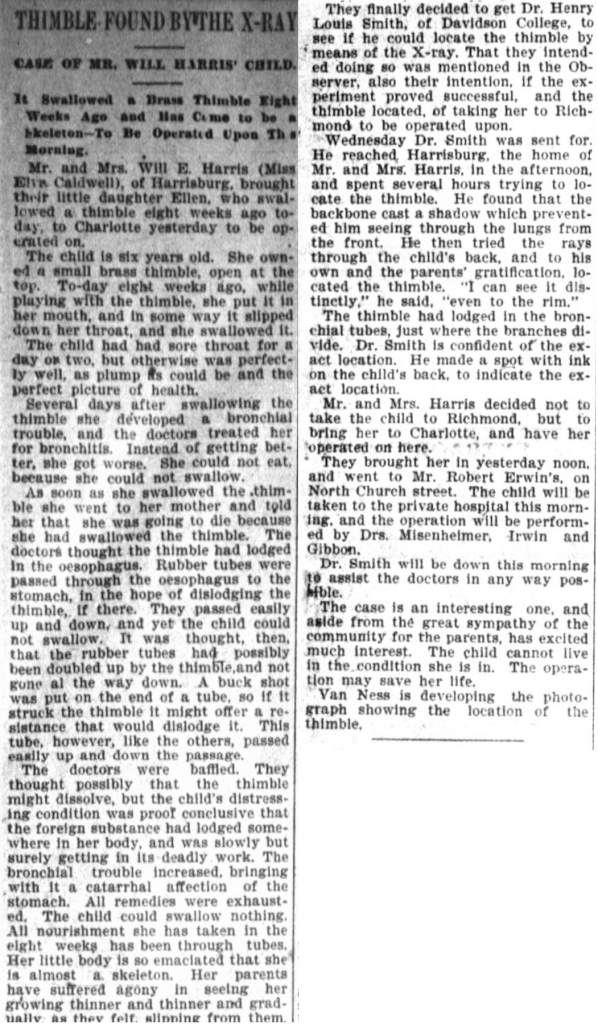
Charlotte Daily Observer, January 7, 1898
Over the next year, we’ll be adding millions of newspaper images to DigitalNC. These images were originally digitized a number of years ago in a partnership with Newspapers.com. That project focused on scanning microfilmed papers published before 1923 held by the North Carolina Collection in Wilson Special Collections Library. While you can currently search all of those pre-1923 issues on Newspapers.com, over the next year we will also make them available in our newspaper database as well. This will allow you to search that content alongside the 2 million pages already on our site – all completely open access and free to use.
This week’s additions include:
Asheville
Burlington
Charlotte
Durham
Graham
Greensboro
Highlands
Milton
Salem
Southport
Spencer
Statesville
Tarboro
Thomasville
Wadesboro
Waynesville
Wilson
Windsor
If you want to see all of the newspapers we have available on DigitalNC, you can find them here. Thanks to UNC-Chapel Hill Libraries for permission to and support for adding all of this content as well as the content to come. We also thank the North Caroliniana Society for providing funding to support staff working on this project.
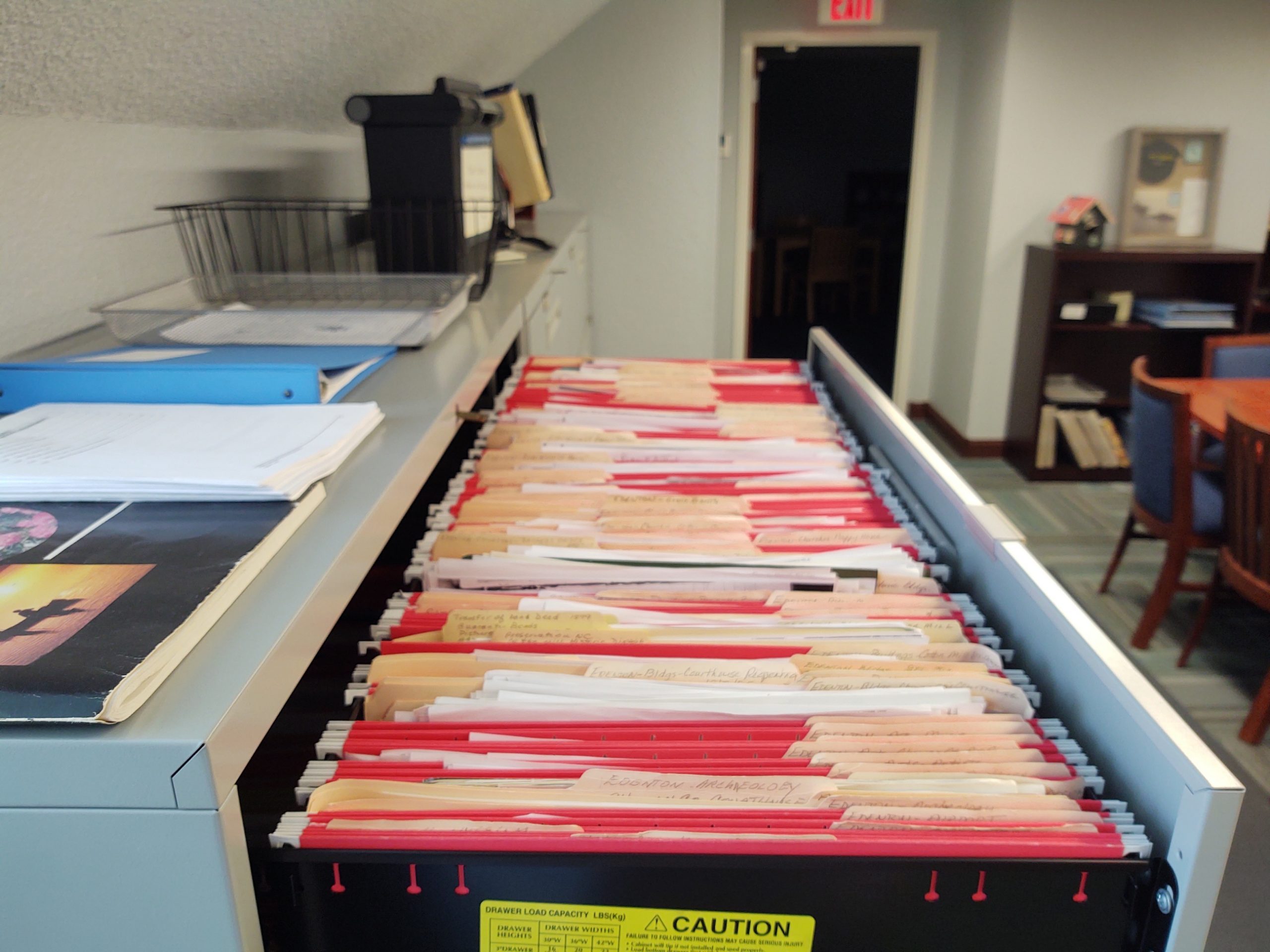 Vertical files are groups of subject-based materials often compiled over time to help an organization’s staff with frequent reference questions or research. Like the example above at Shepard-Pruden Library in Edenton, NC, they’re typically housed in filing cabinets. They are a good place to store items that wouldn’t necessarily be cataloged or accessioned (individually and formally documented by the institution) but are valuable for research. Inside you might find photographs, clippings, family trees, pamphlets, handwritten notes – but because the contents accumulate over time you can find any number of surprises inside.
Vertical files are groups of subject-based materials often compiled over time to help an organization’s staff with frequent reference questions or research. Like the example above at Shepard-Pruden Library in Edenton, NC, they’re typically housed in filing cabinets. They are a good place to store items that wouldn’t necessarily be cataloged or accessioned (individually and formally documented by the institution) but are valuable for research. Inside you might find photographs, clippings, family trees, pamphlets, handwritten notes – but because the contents accumulate over time you can find any number of surprises inside.
Vertical files are also the worst – for digitization that is. The same thing that makes them valuable for research – their convenience, their long term growth, and the variety of contents – makes them incredibly challenging to scan. If you’re interested in digitizing vertical files, we have suggestions! These have been compiled from our own experience at NCDHC along with the experiences of a number of our partners who kindly responded to a recent email asking for advice.
When facing full filing cabinets you may be tempted to dive in right at the beginning and get going, but we always suggest starting with a pilot project using a subset of materials. We can’t emphasize this enough! It’ll give you a sense of workflow, help you establish how you’re going to name and organize the scanned files, and uncover obstacles you didn’t anticipate. If it goes poorly, you can back out without losing a large investment. The suggestions below can be used for a pilot and for a full-fledged project.
Suggestion 1: Prep First, Thank Yourself Later
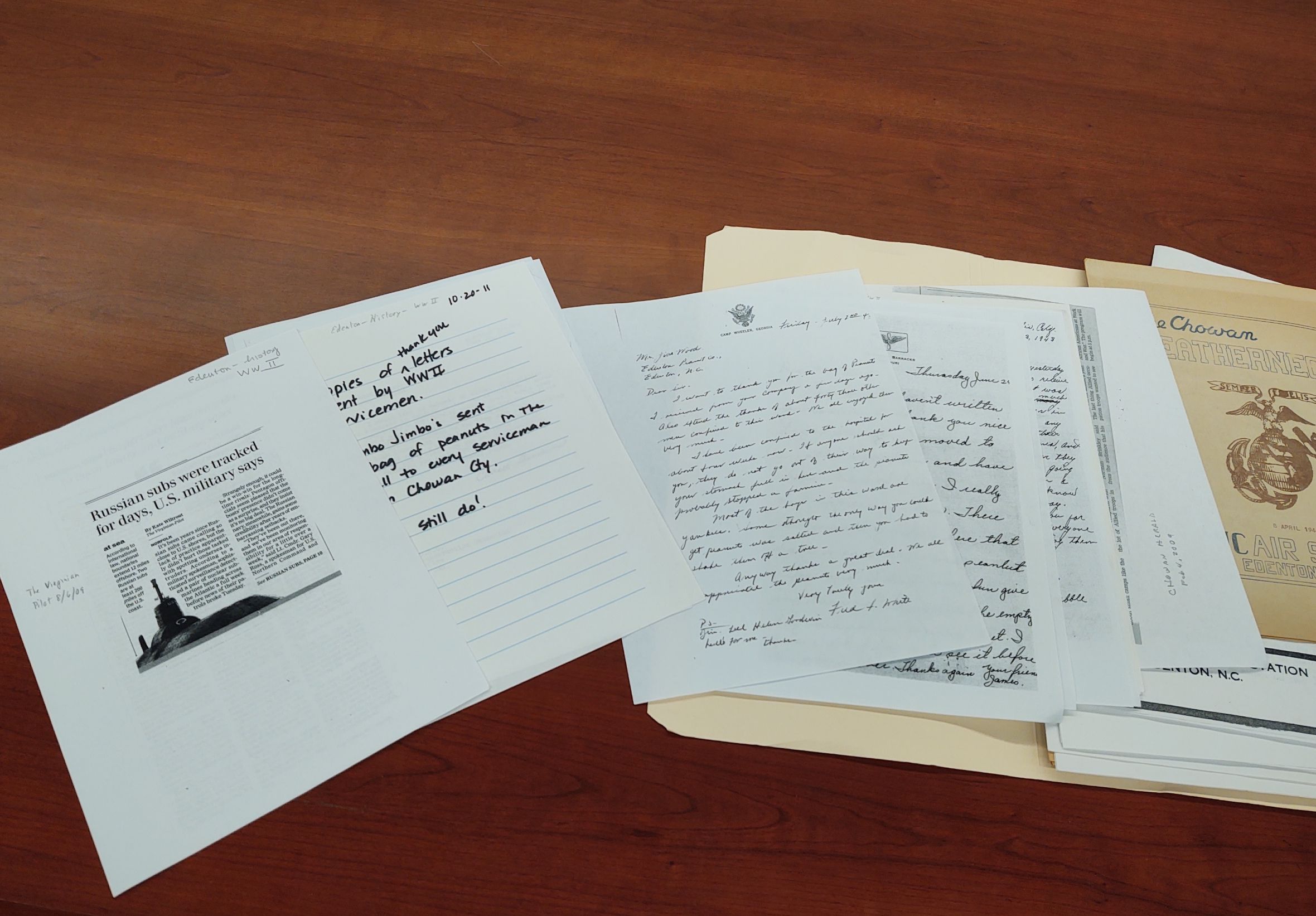
Here’s an example of a vertical file with newspaper clippings, letters, and publications about World War II. From the collection at Shepard-Pruden Library in Edenton.
Scan it all or be selective? Decide if you want to go from beginning to end or to be selective about what you’ll scan. There’s no right answer but each way has ups and downs. This decision will be subject to your users’ needs and your local resources.
Scan it all? Is there enough high value and unique content in your vertical files to warrant scanning everything? For example, some newspaper titles have been digitized in their entirety and are full text searchable (like those available at DigitalNC or Chronicling America) so you might decide that scanning clippings from those same papers is superfluous. As another example, many books published before 1924 in the United States are available online at the Internet Archive or through a simple search in your internet browser. If your files have a lot of book excerpts you may want to skip those.
Be selective? Being selective can be more time consuming and you may unintentionally miss items that would be of use, but it can be appropriate if you’re trying to simply scan items related to one or two topics or for a particular event. It is also a great option if you don’t have a lot of time or resources but want to help give access to high demand files.
First pass for organization. Go through the files in a first pass, during which you’ll assess the files’ contents, sort them in a way that will make scanning easier, and prepare the different formats for scanning. Here are some tasks to complete as you make a first pass:
- Pull out items to be cataloged separately. As your organization’s collection strategies have changed over time you may find materials within the files that should be pulled out and cataloged or accessioned independently. For example, perhaps you are a library where pamphlets were previously stuck in vertical files but are now cataloged and put on the shelf. These can be pulled out and dealt with separately.
- Weed. Take this opportunity to weed out duplicates and look for misfiled items.
- Group items with copyright or privacy concerns. I talk about this in more detail below, but if you plan to put these files online, you may want to skip scanning items that would be too risky or unethical to share online. You could put them towards the back of each file with a divider that indicates they should be either reviewed in more detail or skipped while scanning.
-
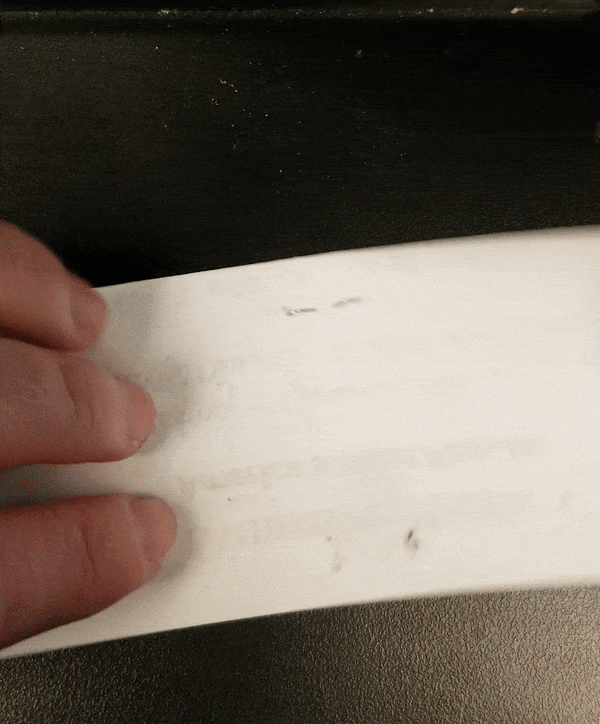
Ashlie, an NCDHC staff member, uses a microspatula to pry up staple legs. License: CC0
Remove staples and fasteners. The caveat here is that you should only do this with materials you’re sure you’re ready to scan. One partner mentioned that staff had removed staples and paperclips from a large quantity of files, but then the project got stalled. Because the vertical files were still in use, this led to papers being misfiled, shuffled out of order, and lost.
- Organize by type then by date. Within each file, organize individual items first by format of item, then by date. Group all of the photographs. Put like sized publications together. Group all of the single page items, all of the clippings. Putting like sized types together will speed up the workflow, saving time when scanning by streamlining your efforts at cropping. Once you’ve grouped things by type, within each group put things in date order (if dates are available). This will help you when you make the scans available.
Suggestion 2: Prepare for the Digital Files
Unless you don’t have that many vertical files (or you have a LOT of time and help) think of each vertical file as a single unit. Here’s what I mean by this. If you have a vertical file about a popular local landmark called the “Turtle Log,” and it includes a few photos, some clippings, and a handwritten narrative, all of those scans would be kept together in a virtual group, folder, or album just as they are in real life. When you describe that group/folder/album either in an internal or online database, you’d describe the unit as a whole, rather than describing each individual photo, clipping, or narrative. This will save a ton of time.
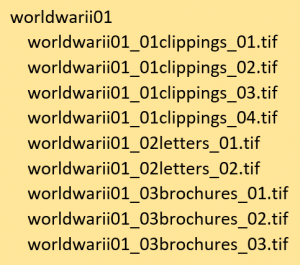 With this in mind, you’ll want to think of a file naming scheme that will keep all of these digital groups organized. Thankfully, file systems mimic files in real life, with the use of folders. Make sure you have a consistent naming convention for files and folders that ensures everything sorts appropriately. On the right is a quick example of how you might decide to name your files. This example is very basic – you could choose to give more detail, include known dates. But note the numbers (01, 02, etc.) included that will make the files sort in order.
With this in mind, you’ll want to think of a file naming scheme that will keep all of these digital groups organized. Thankfully, file systems mimic files in real life, with the use of folders. Make sure you have a consistent naming convention for files and folders that ensures everything sorts appropriately. On the right is a quick example of how you might decide to name your files. This example is very basic – you could choose to give more detail, include known dates. But note the numbers (01, 02, etc.) included that will make the files sort in order.
Suggestion 3: Determine How You’ll Work with Additions
If you intend to keep these vertical files active after scanning, you’ll need to figure out how to denote what’s been scanned and what you’ll do with new additions to the files. A light pencil mark or some other non-permanent note on the back of all scanned items can signal what’s been scanned. Decide if you have the time and staff to scan new additions before filing new donations or if you plan to do that wholesale at a later date. It might also be helpful to have a marker of some sort that you can insert into the file cabinets that lets researchers and staff know about files that have been removed for scanning and whether or not they can still request them.
Suggestion 4: You Should Scan these In House. Or You Shouldn’t.
I wish I could give a single way forward here, but like so many things the answer to whether or not to outsource scanning depends on your situation. Here are a few considerations for the two routes.
Scanning in house. This gives you a lot of flexibility. You can work on the project over time. For active files, they’ll be close at hand if needed. Your staff will gain experience scanning, if they don’t already have it.
Unless you can afford an overhead scanner or camera mount setup, scanning vertical files on a flatbed or other multifunction machine will make a very long process a lot longer. Sheetfed scanners can speed things up a little but only for extremely uniform, non-unique materials that are in good shape. Because the project is large, if you don’t have dedicated scanning staff (or even if you do) be prepared for the contents of multiple file cabinets to take years to scan. You may also need to hire new staff or reskill current staff to do this work, trading this for other duties they currently complete.
Outsourcing scanning. Outsourcing can mean a quicker outcome because the organization doing the scanning will have dedicated workflows and equipment for high volume output. If you don’t have digitization expertise on staff, their expertise can be helpful for avoiding pitfalls.
Unless you are working with an organization that typically scans special collections, the variety of formats can be a challenge and frequently increase the cost. Companies that specialize in corporate files will claim attractively inexpensive prices for scanning but they are frequently used to working with homogenous typing or copy paper. Be sure to interrogate them regarding their expertise, showing them examples and even asking for a quote after they scan a subset. Make sure they offer digital files of a quality and in file formats that you can use into the future.
Suggestion 5: Decide About Your Access Priorities and the Rest will Follow
As we’re fond of saying, digitization is the easy part. Even in a project of this size and complexity, the scanning and preparation of the digital files is more straightforward then what comes next. Here are confounding factors to take into account when you consider how you’ll provide access to the digital vertical files.
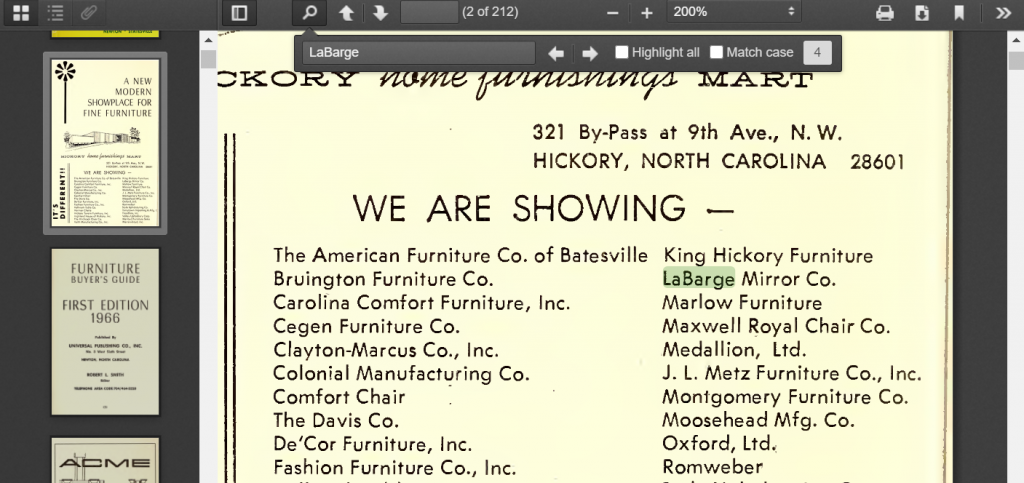 Full Text Search
Full Text Search
Full text search greatly increases the usefulness of digital vertical files. It’s one of the most cited reasons for scanning them in the first place. To be able to search full text within a scanned document, you’ll need to run that digital file through software that recognizes the text and then either embeds it within the file or stores it separately. (Note that this will only happen with typewritten text – accurate automated recognition of handwriting isn’t widely available at this point.) Here are two different options:
- Some institutions choose the PDF format for their vertical files. Software like Adobe Acrobat (not to be confused with the freely available Adobe Reader) will recognize text within a PDF. However PDFs are made for easy transmission and sharing, not for longevity and quality. We recommend that you scan initially to a higher quality or lossless format, and then, if it fits your goals and resources, create derivatives like PDFs. The upside of PDFs is that many desktop and laptop computers can natively search across PDFs. This means you could have them searchable locally, say on a reading room computer, and not necessarily have to provide internet access.
- Alternatively, you can use a system that can store both the text recognized in an image and the image itself and then link them together. Some library or museum catalogs will do this, or you’ll need a content management system. This means additional ongoing costs and the need for technological infrastructure and expertise. But with these types of systems you can provide full text search of your files on the internet.
Copyright and Privacy
Copyright is one of the biggest confounding factors related to making vertical files accessible. Depending on how old your files are, it’s likely that there are materials in there that will be in copyright. If you want to post copyrighted materials on the internet, your organization will need to assess the amount of risk you’re willing to accept. Some items are riskier than others. Regardless, whoever is working on your vertical files will need training and the authority to determine what can and should go online and what should not. Here are a few resources to help get you started:
In addition to copyright, you should always consider privacy concerns. For some of the non-published items in your vertical files, the donations or additions were made with the expectation of local use by a single person or small group. Family history documents that discuss recent events are an example of the type of item you may judge to be too personal for broad consumption without the permission of the creator. There may be documents that share information about communities that would prefer they not be shared broadly. These are all good things to assess as you do your first pass.
Suggestion 6: Find Examples and Friends
Here are some examples of digitized vertical file collections online. These are large projects with a goodly number of staff and funding involved, so take that into account as you look. Note that the files are put online whole rather than breaking out individual items.
This first example comes from the Digital Collections of the University Libraries at UNC-Greensboro and showcases their “class folders.” UNC-G has done quite a bit with vertical files of various types, but this is a great example of folders that have a variety of items grouped by subject. These items are in a system called CONTENTdm, which is specifically designed to host special collections.
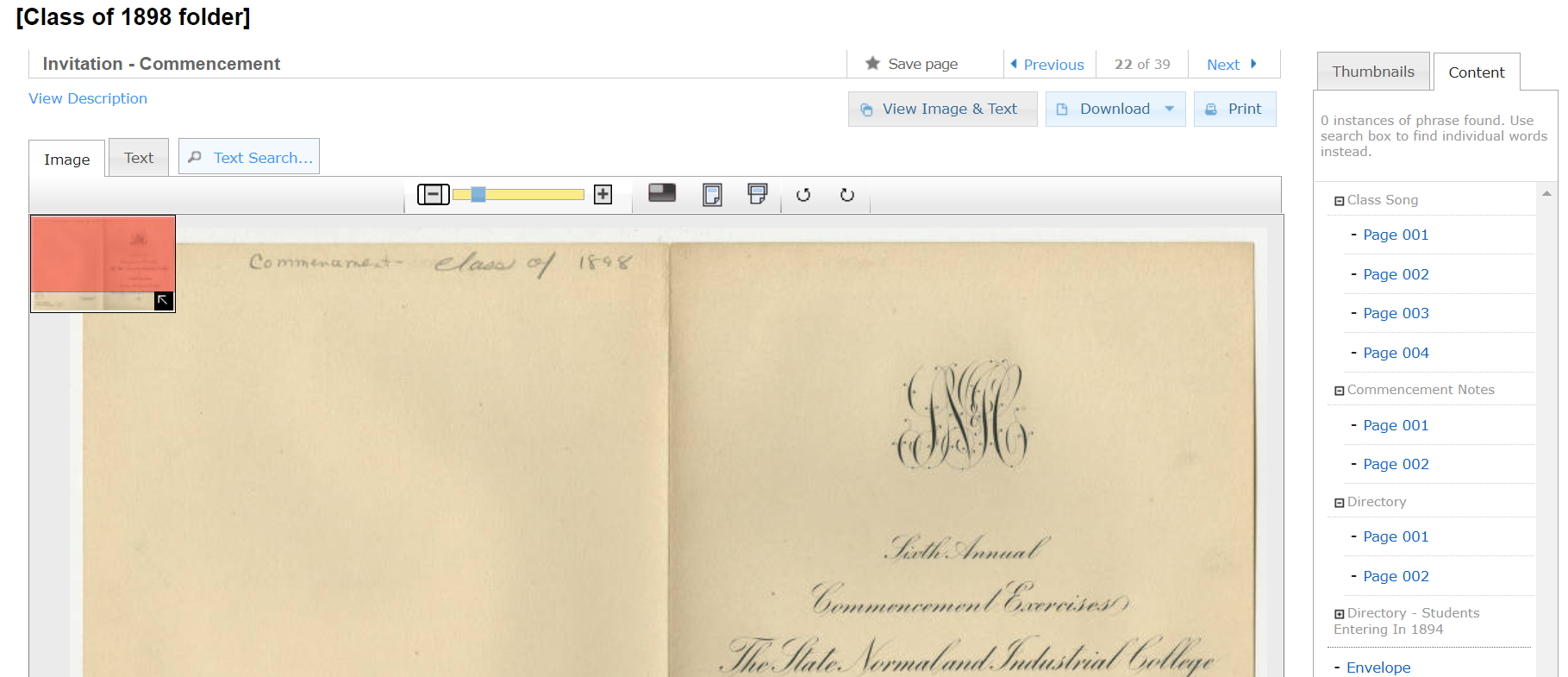
This invitation is one of a number of items in the vertical file entitled “Class of 1898.” You can see the item title at the top and a list of the different items inside on the right.
We’ve also done some vertical files at NCDHC, and you can take a look at an example here. This is from a large collection of vertical files shared by the Kinston Lenoir-County Public Library. Our system is called TIND.
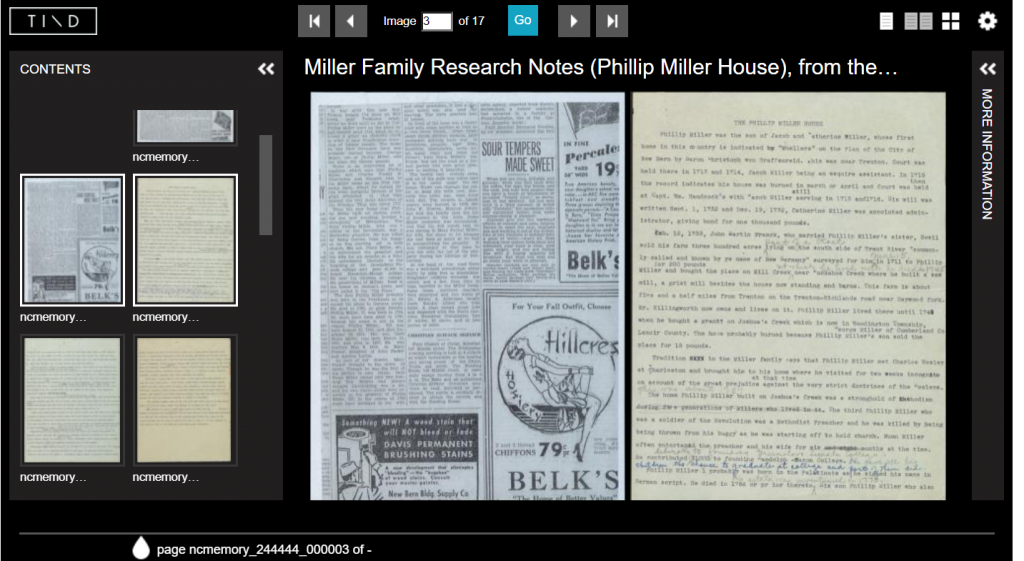
This screenshot shows a large view of a newspaper clipping alongside a typewritten manuscript from the Sybil Hyatt Papers. To the left are thumbnails showing other items in this particular file.
Keep in mind that both of these systems are made for hosting large numbers of special collections items and, like a library or museum catalog, cost money and staff to maintain. While it’s outside of the scope of this article, you can take a look at another post we did regarding how to share your digital files.
For any digitization project, we heartily recommend trying to find friends and peers at area or regional organizations. Ask if they have vertical files or digitization projects (or both?!). A quick phone call or email can help you avoid duplication of effort, at the least, and may gain you advice or a collaboration. You can even choose to share staff or other resources, or collaboratively apply for funding. We also like to be friends! If you’ve made it this far and still want to digitize, but you have questions or would like additional advice, feel free to get in touch.
A couple of weeks ago UNC’s university archivist tweeted about finding articles in the Daily Tar Heel about a flu epidemic on UNC’s campus in early 1941. Intrigued – and figuring it was in no way contained to UNC’s campus – we did some digging in other newspapers on our site to find other stories about the epidemic’s impact on other campuses in NC at the time. A topic that is feeling quite relevant now, we found mentions scattered throughout the papers in January and February 1941 (for context – what would have been a year that started with an epidemic for these students and ended with the country involved in a World War) about how students were reacting to this sudden uptick in the flu.
Several campuses seemed to have a newfound appreciation for the infirmary, with an “Ode the Infirmary” published in Mars Hill College’s student newspaper.
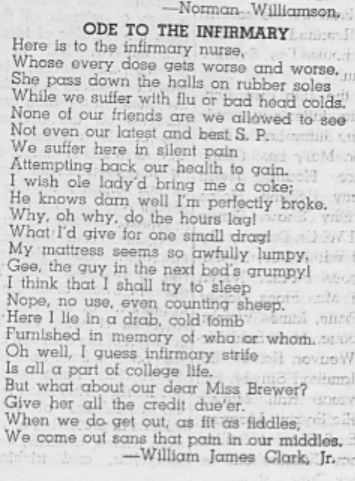
From the Montreat College paper, a look “Through the Infirmary Door”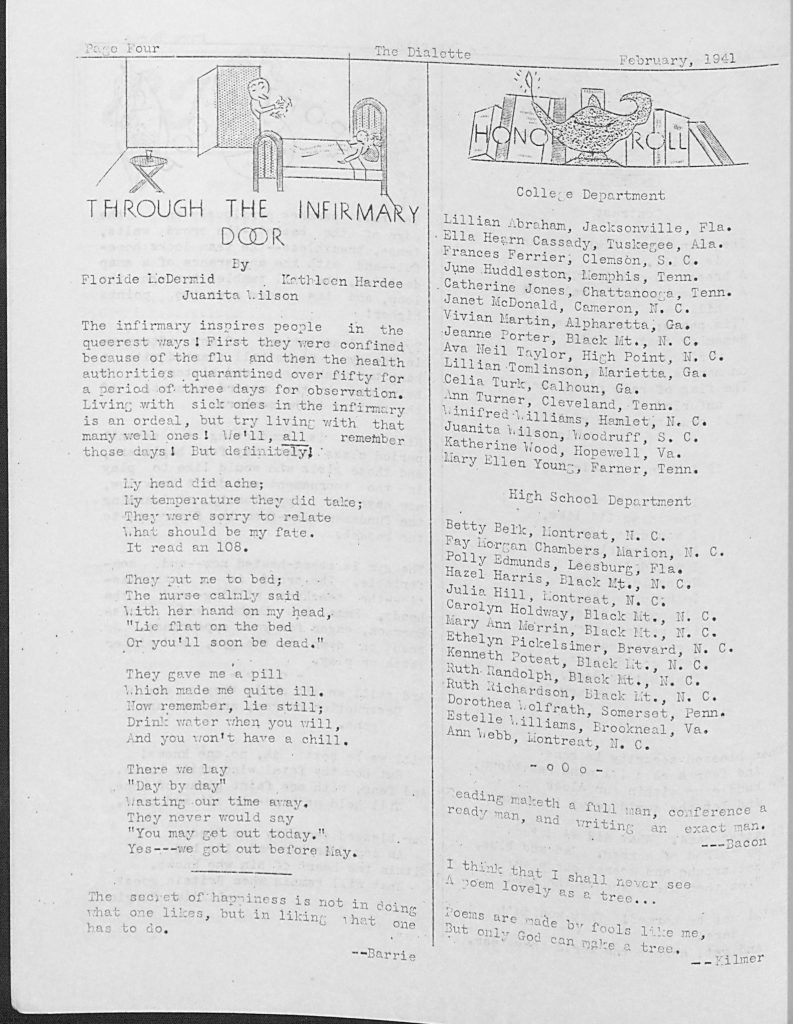
The social lives of the Belles of Saint Mary’s were put on hold for the flu that struck campus in mid January. Their society pages in their student newspaper detail such and the following flurry of activity as they were able to come out of quarantine.
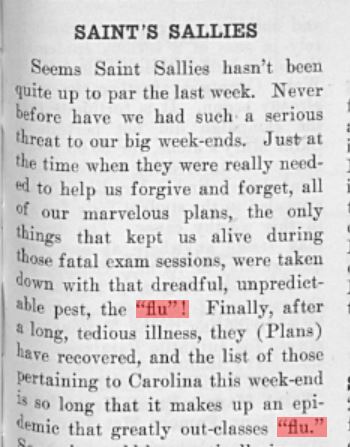
At the high school level, reports of basketball games and academic competitions were cancelled or put on hold as school was cancelled for several days to prevent the spread of the flu virus. Both the students at Greensboro High School and High Point School reported such.
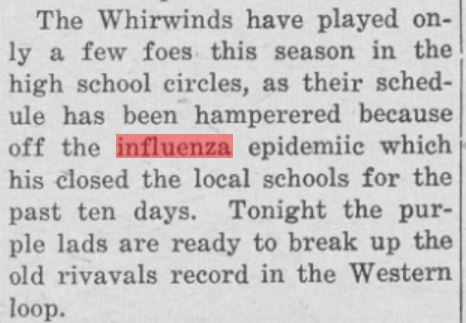
Other social and academic events were also cancelled – all citing the epidemic as the cause.
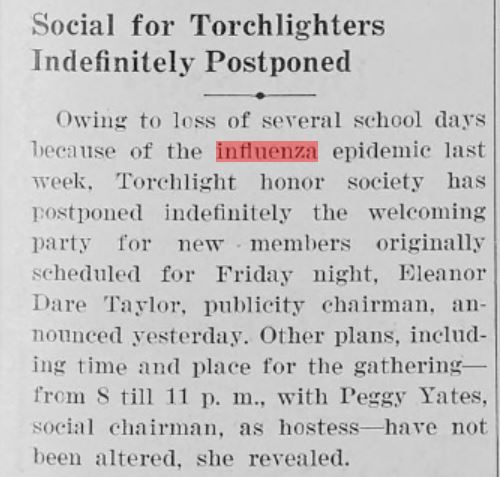
Other college campuses did not seem to have large effects from the flu but did report on students who were travelling from other areas of the state who then had to quarantine upon arrival on campus. For example, in an article in Montreat College’s student paper, they reported on students who had to quarantine upon arriving back to campus.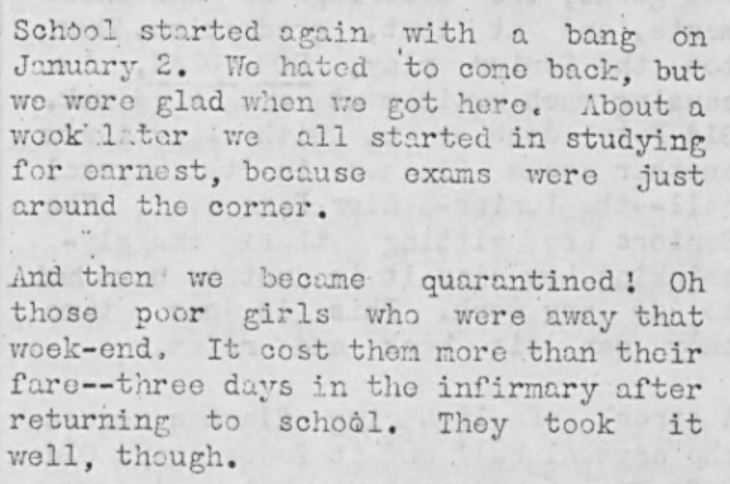
All in all, nothing quite as dramatic as what appears to have happened at UNC was going on at other North Carolina schools, perhaps another echo of what has happened in 2020. A brief perusal of the community papers from the time show that the flu epidemic was something affecting the whole state for sure, with mentions of it in papers from as far east as Beaufort, NC and as far west as Franklin, NC in Macon County.
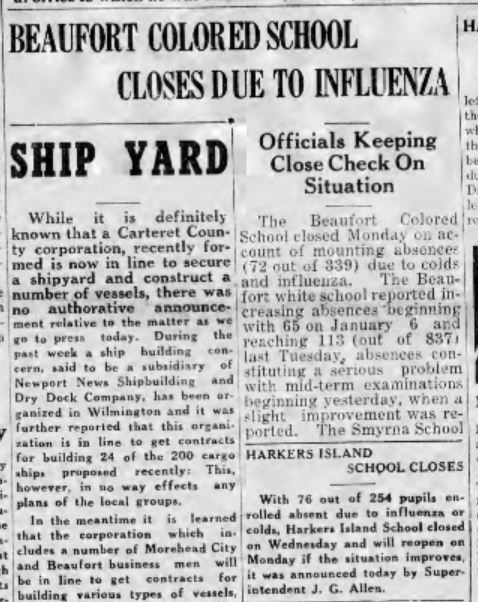
Clipping from The Beaufort News , January 16, 1941
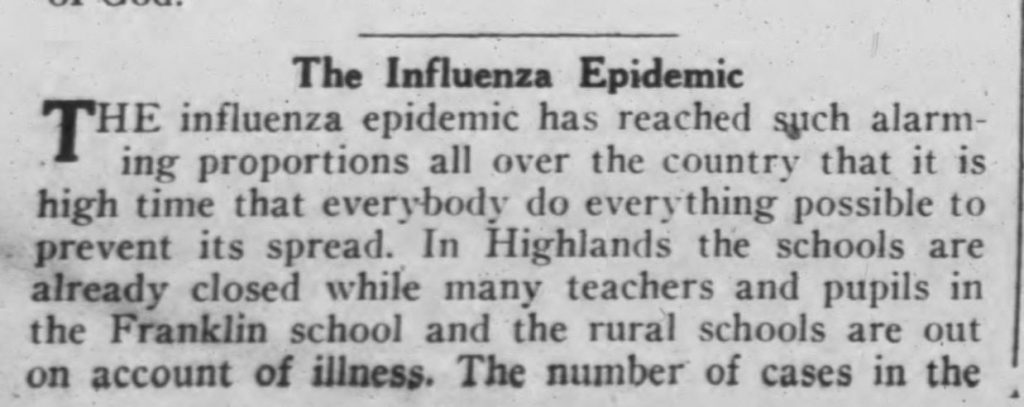
Clipping from The Franklin press and the Highlands Maconian, January 23, 1941
Several articles note that this particular epidemic was moving from the western part of the state to the eastern part of the state, which was apparently unusual, and overall cases had been fairly mild (which likely explains in part why it rarely pops up as an event in history).
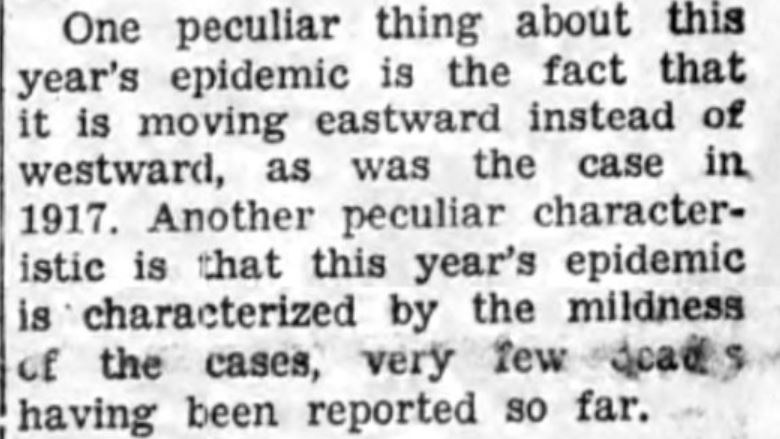
January 22, 1941 issue of the State Port Pilot discussing the effects of the flu across the state.
To explore our over 1 million pages of digitized newspapers yourself, visit our North Carolina Newspapers page and read here about how colleges in NC responded to the 1918 Spanish Flu pandemic.
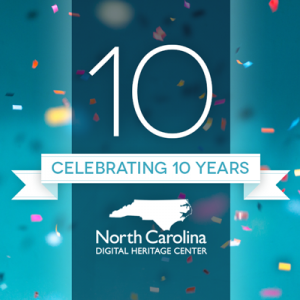 It’s DigitalNC.org’s 10th birthday! Though we had hoped to be in the office celebrating, we’re still taking time to look back at years of hard work and the collaborative spirit that makes the North Carolina Digital Heritage Center (NCDHC) what it is!
It’s DigitalNC.org’s 10th birthday! Though we had hoped to be in the office celebrating, we’re still taking time to look back at years of hard work and the collaborative spirit that makes the North Carolina Digital Heritage Center (NCDHC) what it is!
To date, NCDHC has partnered with 273 libraries, museums, alumni associations, archives, and historic sites in 98 of North Carolina’s 100 counties and we’re growing all the time. Our website currently includes 4.2 million images and files. We share this accomplishment with every institution we’ve worked with. We’d never have gotten to 10 years without staff (permanent, temporary, and student!), our partners, or the network of colleagues all over North Carolina who have encouraged, advised, and supported our work.
As we approached our anniversary, we realized that our website lacked a synopsis of how NCDHC came to be, and our history. So read on for a brief look at how we got started and our major milestones.
Our History
The North Carolina Digital Heritage Center was one outcome of a comprehensive effort by the state’s Department of Cultural Resources (now the Department of Natural and Cultural Resources) to survey and get a broad overview of the status of North Carolina cultural heritage institutions. That effort was entitled NC ECHO (North Carolina Exploring Cultural Heritage Online) and was funded by the Institute of Museum and Library Services (which also supports us – thanks IMLS). A major goal of NC ECHO was a multi-year needs assessment. NC ECHO staff visited hundreds of cultural heritage institutions throughout the state to collect data and interview curators, librarians, volunteers, archivists, and more. Many of our partners still remember their visits!
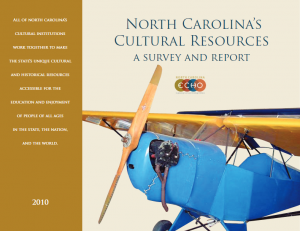 Data collected at these site visits was combined with survey responses to reveal a “state of the state,” summarized in a 2010 report, cover pictured at right. The assessment revealed a lot but, specific to digitization, staff found that nearly three-quarters of the 761 institutions who completed the survey had no digitization experience or capacity. Members of the Department of Cultural Resources (which includes the State Library, State Archives, and multiple museums and historic sites) began brainstorming with other area institutions about a way to help efficiently and effectively provide digitization opportunities. While the NC ECHO project offered digitization grants, workshops, and best practices, an idea emerged of a centralized entity that could assist institutions that didn’t have the capacity to do the work in house. The State Library of North Carolina and UNC-Chapel Hill Libraries joined together to create such an entity: the North Carolina Digital Heritage Center. The Center would be located in Chapel Hill, taking advantage of its central location and the digitization equipment and expertise already available in Wilson Special Collections Library. The State Library would provide funding, guidance, and ongoing promotion and support of the Center’s services.
Data collected at these site visits was combined with survey responses to reveal a “state of the state,” summarized in a 2010 report, cover pictured at right. The assessment revealed a lot but, specific to digitization, staff found that nearly three-quarters of the 761 institutions who completed the survey had no digitization experience or capacity. Members of the Department of Cultural Resources (which includes the State Library, State Archives, and multiple museums and historic sites) began brainstorming with other area institutions about a way to help efficiently and effectively provide digitization opportunities. While the NC ECHO project offered digitization grants, workshops, and best practices, an idea emerged of a centralized entity that could assist institutions that didn’t have the capacity to do the work in house. The State Library of North Carolina and UNC-Chapel Hill Libraries joined together to create such an entity: the North Carolina Digital Heritage Center. The Center would be located in Chapel Hill, taking advantage of its central location and the digitization equipment and expertise already available in Wilson Special Collections Library. The State Library would provide funding, guidance, and ongoing promotion and support of the Center’s services.
At its beginning, the Center’s staff digitized small collections of college yearbooks, needlework samplers, postcards, and photographs and made them available through DigitalNC.org. They went to speak with organizations interested in becoming partners, and began taking projects for digitization. Here’s a list of NCDHC’s earliest partners, who came on board during late 2009 and 2010.
Though we’re not positive of the exact date, we believe DigitalNC.org launched on or near May 12, 2010. Here’s a look at that original site!
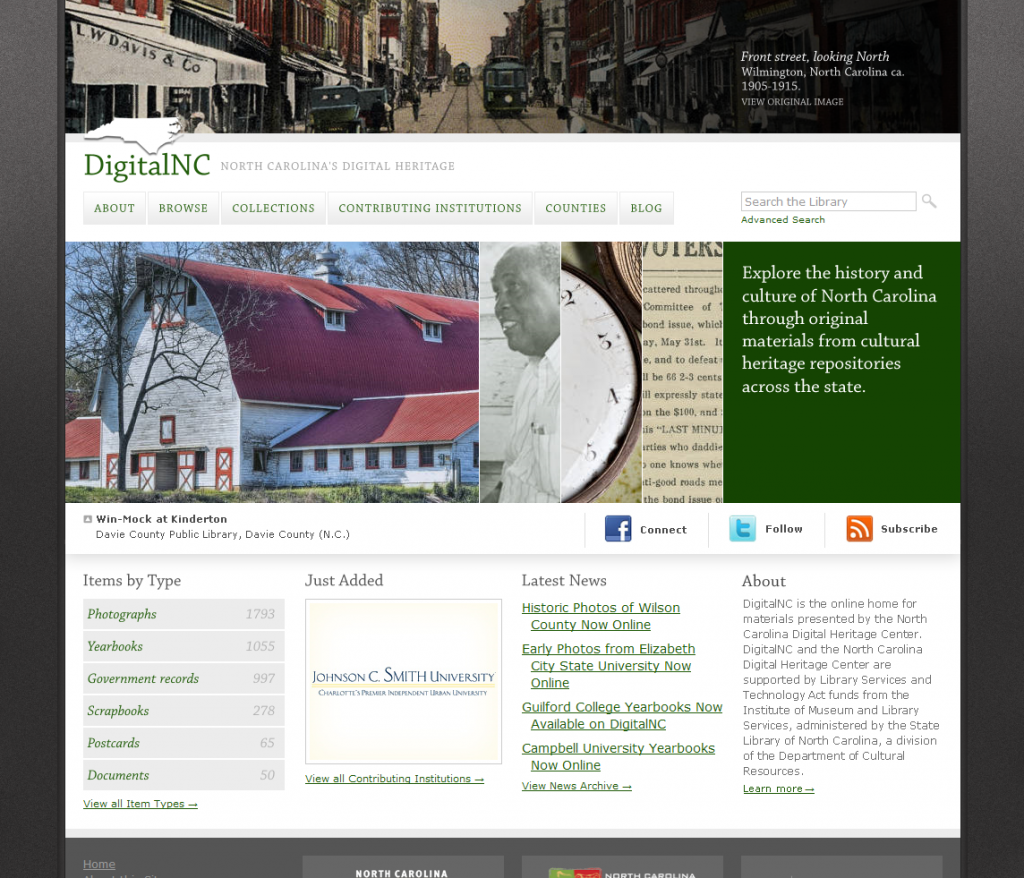
In 2011, word about the Center spread. Staff started responding to demand from partners, incorporating newspaper digitization. In late 2012, also in response to popular demand, the Center began digitizing high school yearbooks. Yearbooks and newspapers are some of the most viewed items on DigitalNC, and they remain a significant portion of our work to this day.
In 2013, NCDHC joined the Digital Public Library of America (DPLA) as North Carolina’s “service hub.” The DPLA collects information from digitized collections all over the nation and provides it together in one searchable interface at dp.la. Because of our participation, users can browse and search for collections from North Carolina alongside items from institutions around the country.
Throughout the years, we’ve tried to expand services to fit our partners’ goals. In 2015, we trialed an audiovisual digitization project that incorporated the first films into DigitalNC. Today, we partner with the Southern Folklife Collection at Wilson Special Collections Library to provide audio digitization on an ongoing basis. In 2016, we added a new partner category – alumni associations – to support more digitization of African American high school yearbooks and memorabilia. The following year, we announced a focus on digitization of items documenting underrepresented communities. We also started going on the road with our scanners! For institutions that don’t have the staff time or resources to travel to Chapel Hill, we offer to come for a day or two and scan on site.
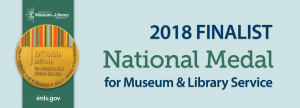 2018 and 2019 saw several major milestones. We were nationally recognized as an Institute of Museum and Library Services National Medal finalist, and we began a major software migration. Both were a tribute to the size and extent of our operation, though in different ways. As we’ve approached our 10th anniversary we’ve focused on working with partners in all 100 of North Carolina’s counties. Whether you’re rural or metropolitan, we believe your history is important and should be shared online.
2018 and 2019 saw several major milestones. We were nationally recognized as an Institute of Museum and Library Services National Medal finalist, and we began a major software migration. Both were a tribute to the size and extent of our operation, though in different ways. As we’ve approached our 10th anniversary we’ve focused on working with partners in all 100 of North Carolina’s counties. Whether you’re rural or metropolitan, we believe your history is important and should be shared online.
One of the ways we’re commemorating this anniversary is to ask our partners and stakeholders how they think we’ve impacted them and their audiences. Join us here on the blog in the second half of 2020 as we share these brief interviews, reflect, and celebrate. Thank you for reading, enjoy the site, and here’s to another 10 years of making North Carolina’s cultural heritage accessible online!
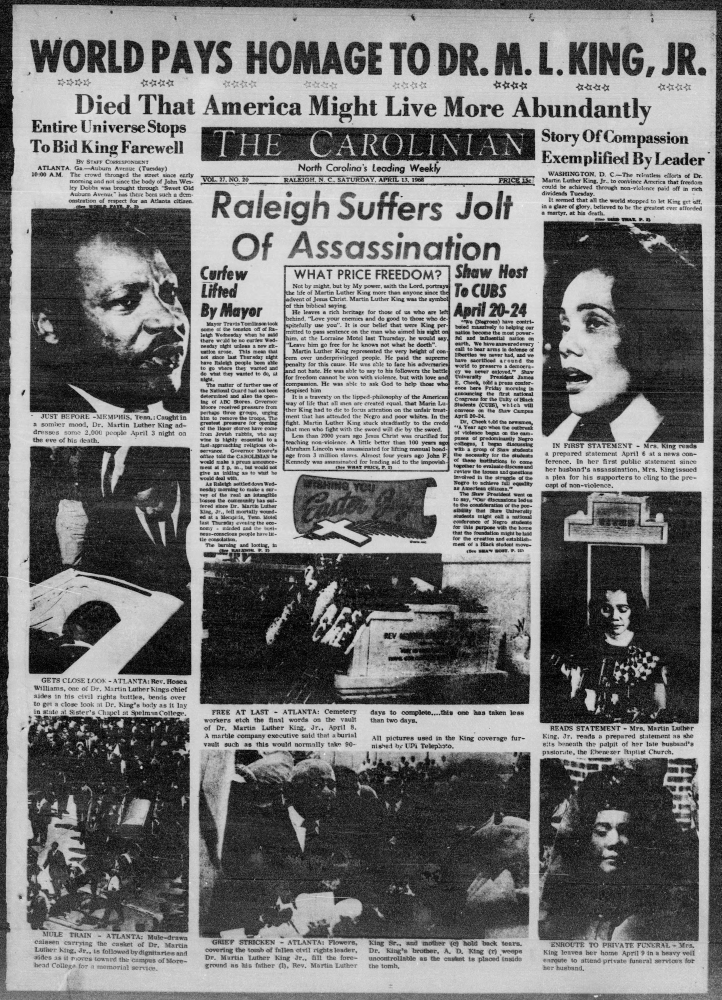
The April 13, 1968 front page of The Carolinian, reporting on the aftermath of Dr. King’s assassination.
The newest issues to DigitalNC of one of Raleigh’s African American newspapers, The Carolinian, cover the most turbulent years of the Civil Rights Era. Recently added are issues from 1959-1962, 1965-1972. These join issues from 1945-1958, 1963-1964, which are already available on our site.
Within these new additions you will find coverage of the sit-ins in Greensboro and throughout the state, North Carolina’s protracted battle over school integration, the assassinations of Malcolm X and Martin Luther King, Jr.. There is ongoing reporting about both local and national efforts of the NAACP, KKK demonstrations and counter-protests, and news about boycotts and protests at the state’s historically Black colleges and universities.
The paper covers local news – achievements of adults and children alike, events, crime. Milestones of integration appear as well, like the first known birth of an African American child at Rex Hospital in Raleigh.
Thanks to Olivia Raney Local History Library in Raleigh for securing permission to share The Carolinian online. You can view all of the issues currently available, as well as everything we’ve scanned for Olivia Raney on their contributor page.
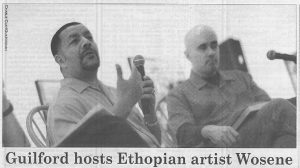
A 2007 article highlighting an exhibition at Guilford College of Ethiopian artist Wosene Worke Kosrof
A new batch of student newspapers have been added to DigitalNC, courtesy of our partner, Guilford College. Included in this collection are nearly 250 issues of The Guilfordian, the student newspaper designed to update, teach, and inform students at Guilford College. Stretching from September of 2005 to May of 2015, this collection represents adding the experiences of nearly 3 generations of college students to our holdings.
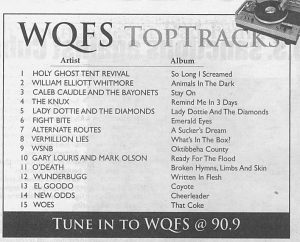
A list of what was being played by student radio station WQFS during the week of April 10, 2009.
The Guilfordian is mostly dedicated to student activity on campus, advertising clubs, events, or speakers coming to Guilford College, it also included other details that students, alumni, or readers may find interesting. For example, as you can see to the left, for several years, the paper included lists of the top tracks played by Guilford College’s own student-run radio station, WQFS 90.9.
While many of the earlier articles are dedicated to student news, news around Greensboro, and activities on campus, readers can see how the direction and editorial stance of the paper changed with each generation of students. Over time, The Guilfordian has developed a stance more towards individual empowerment and highlighting student growth on campus. Just as the paper changed, adding or removing different sections, it is fascinating to see how the student body changed and reacted to different events over the years. For example, as seen below, The Guilfordian covered how Guilford College students demonstrated in Occupy Greensboro in the fall of 2011.

Guilford College students took to the streets in Occupy Greensboro in fall 2011.
To see more issues of The Guilfordian, click here. To learn more from Guilford College, you can see more information by visiting their partner page or taking a look at their website.
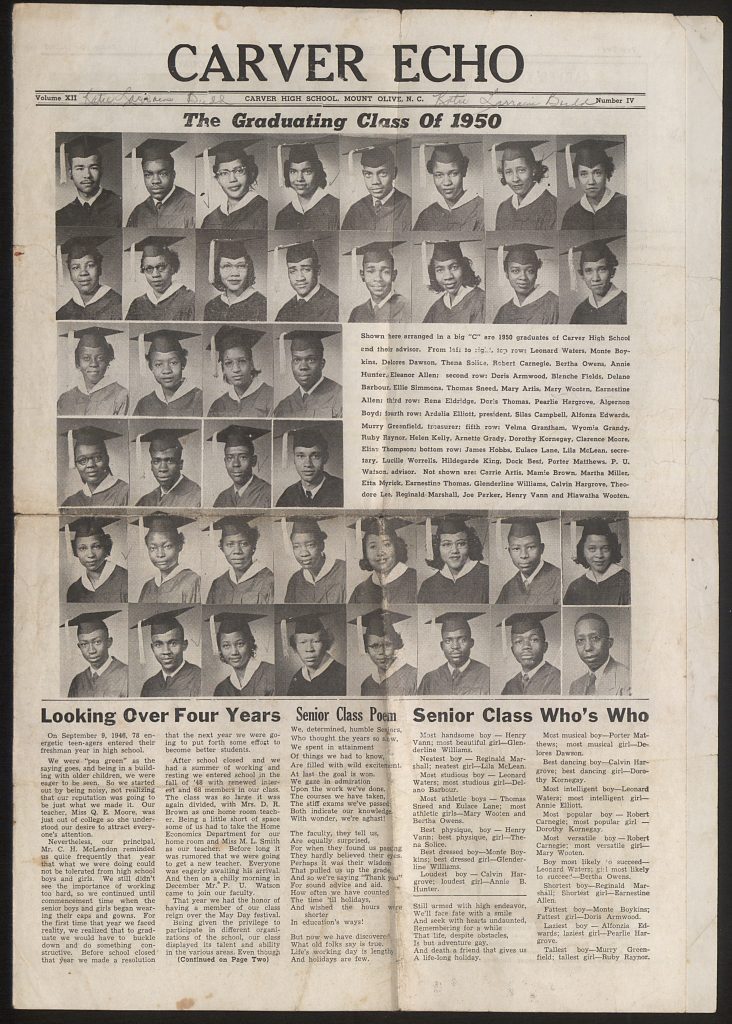
The only issue we have (so far) of a Carver High School newspaper. Mount Olive, NC, May 1950.
From our estimation, DigitalNC shares more digitized historical North Carolina African American newspapers than any other source. Contributors range from our state’s HBCUs to local libraries and museums. To help pull these titles together, we created an exhibit page through which you can search and browse eleven community papers and nine student papers. There are also links to more available on other sites.
Below we’ve re-posted the essay from the exhibit, giving you a brief history of these papers. We hope that we’ll hear from others who may be interested in sharing more of these rare resources online.
~~
Since the publication of Freedom’s Journal in 1827 in New York City, African American newspapers have had a long and impactful history in the United States. Begun as a platform to decry the treatment of enslaved people, the earliest African American newspapers appealed to whites, who were politically enfranchised. After the Civil War, as newly freed African Americans claimed the right to literacy, the number of African American newspapers around the country grew exponentially and the editors began addressing Black people instead of whites. Papers turned their focus from slavery to a variety of subjects: religion, politics, art, literature, and news as viewed through the eyes of African American reporters and readers. Communication about Black political and social struggles through Reconstruction and, later, the Civil Rights movement, cemented newspapers as integral to African American life.
In North Carolina, the first African American papers were religious publications. The North Carolina Christian Advocate, which appears to be the earliest, was published from 1855-1861 by the North Carolina Conference of the Methodist Episcopal Church, followed by the Episcopal Methodist, a shorter-lived publication produced during the Civil War by the same organization. After the Civil War, the number of African American newspapers continued to grow in North Carolina, reaching a peak during the 1880s and 1890s with more than 30 known titles beginning during that time.
The longest running African American paper established in North Carolina is the Star of Zion, originating in Charlotte in 1876 and still being produced today. Other long-running papers in the state include the Charlotte Post (begun 1890), The Carolina Times (Durham, begun 1919), the Carolinian (Raleigh, begun 1940), Carolina Peacemaker (Greensboro, begun 1967), and the Winston-Salem Chronicle (begun 1974). Many of these long running papers powerfully documented Black culture and opinion in North Carolina during the 1960s-1970s, with numerous editorials and original reporting of local and national civil rights news.
Occasionally overlooked sources for African American newspapers are North Carolina’s Historically Black Colleges and Universities (HBCU) and, before integration, African American high schools. You’ll find links on DigitalNC to newspapers from eight of North Carolina’s twelve current and historical HBCUs as well as two African American high schools.
While many African American newspapers have found their way into archives and libraries, it’s common to see broken runs and missing issues. You can find a great inventory of known papers from the UNC Libraries. If you work for a library, archive, or museum in North Carolina holding additional issues and would like to inquire about digitizing them and making them available online, please let us know.
The quote in this post’s title comes from a student who participated in a 1989 protest at UNC-Chapel Hill, pictured below.
One of the most historic student protests in the United States happened on this day in 1960 right here in North Carolina. NC A&T students protested segregation by sitting down at a segregated Woolworth’s lunch counter in Greensboro. The first images in this post were taken at that event and come from the 1960 Ayantee yearbook. Other images come from schools in all parts of the state, and date from 1960 through 2012.
North Carolina college students have passionately protested a variety of issues and events over the years. Looking back through yearbooks and student newspapers, you’ll find editorials with strong opinions and photographs of students standing up and speaking out in this most public of ways. Today we’re sharing the tradition of protest by students over the years, as reported in their own media.
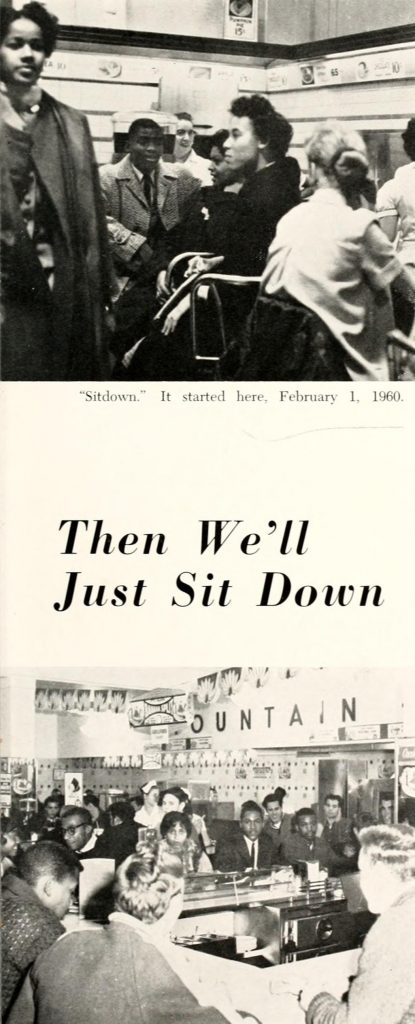
North Carolina Agricultural and Technical College, 1960, Segregation (Woolworth’s Lunch Counter, Greensboro)
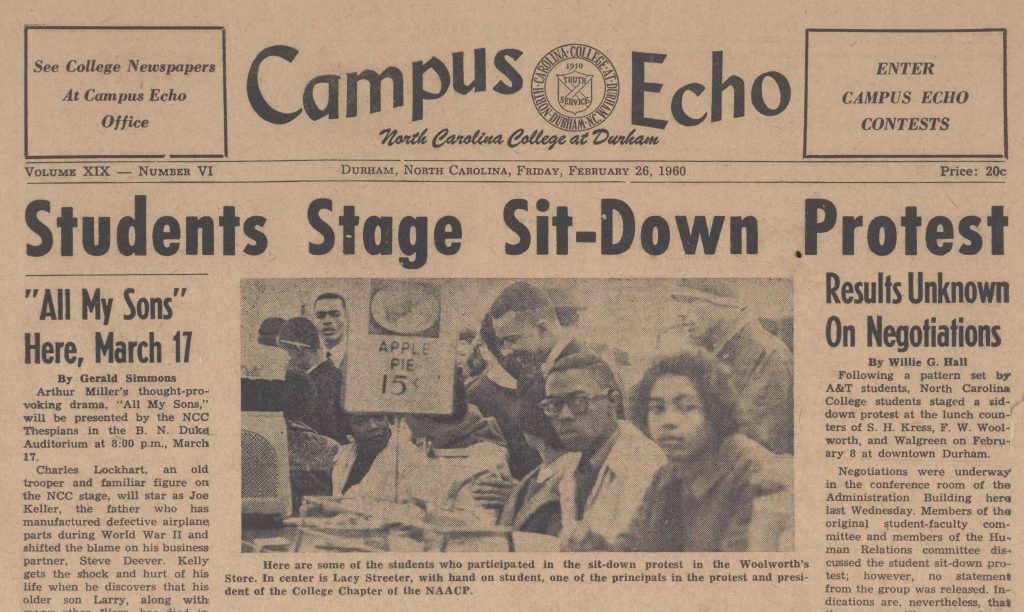
North Carolina Central University, 1960, Segregation (Woolworth’s Lunch Counter, Durham)
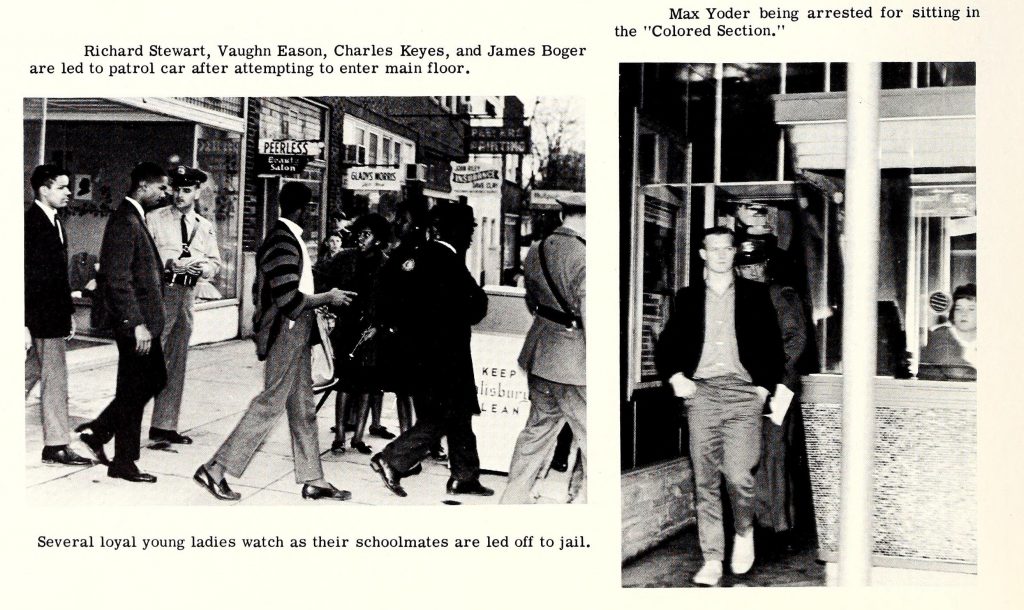
Livingstone College, 1961-1962, Segregation (Capitol Theater, Salisbury)
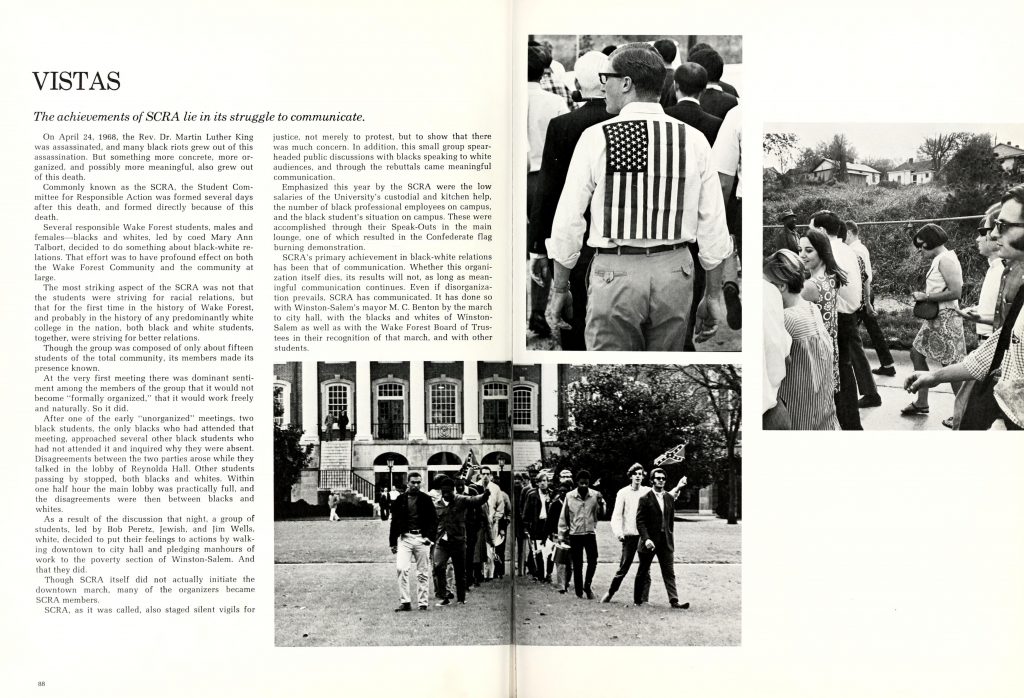
Wake Forest University, 1969, Assassination of Dr. Martin Luther King, Jr.
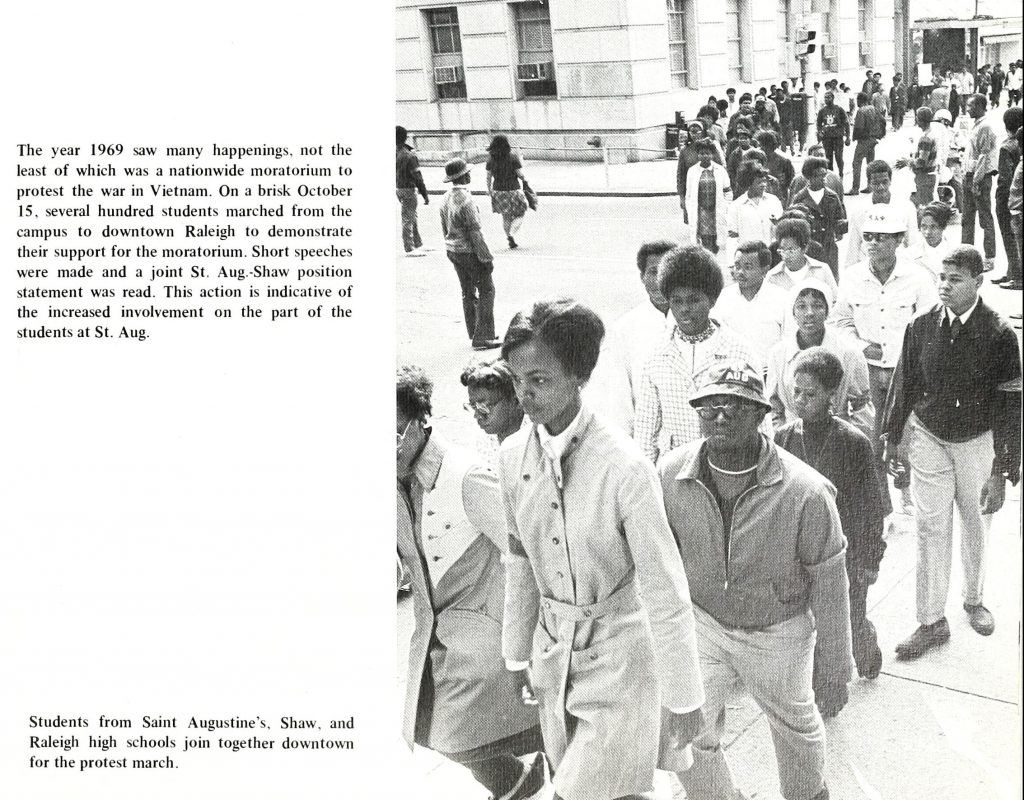
Saint Augustine’s, 1970, Vietnam War
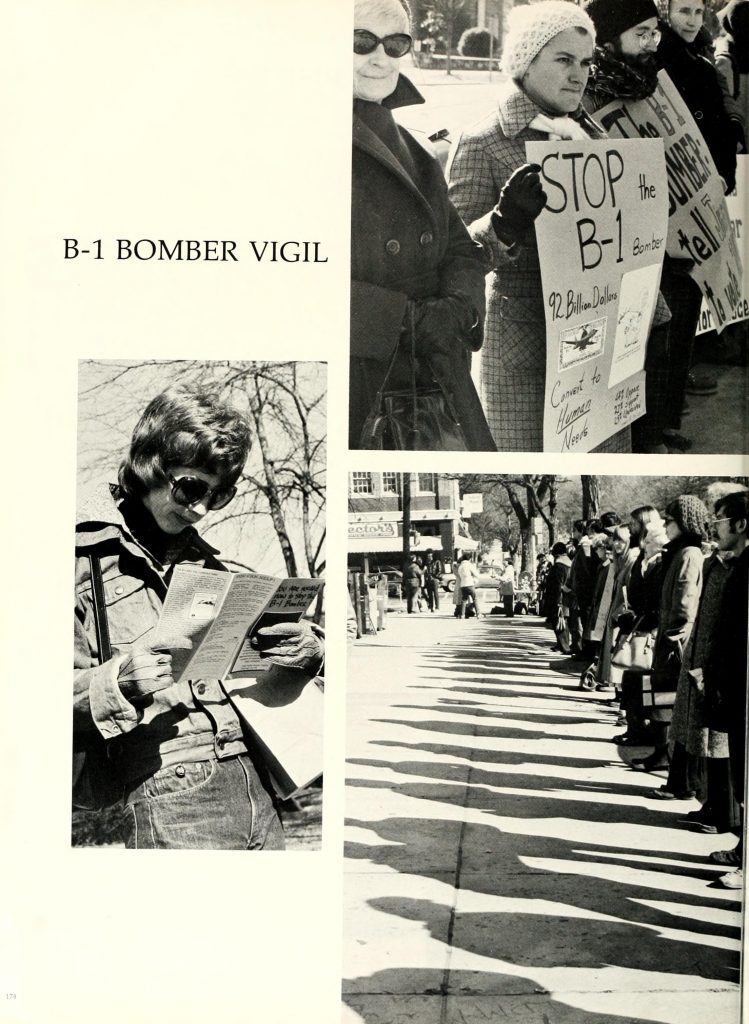
UNC-Chapel Hill, 1977, B-1 Bomber and Nuclear Armament
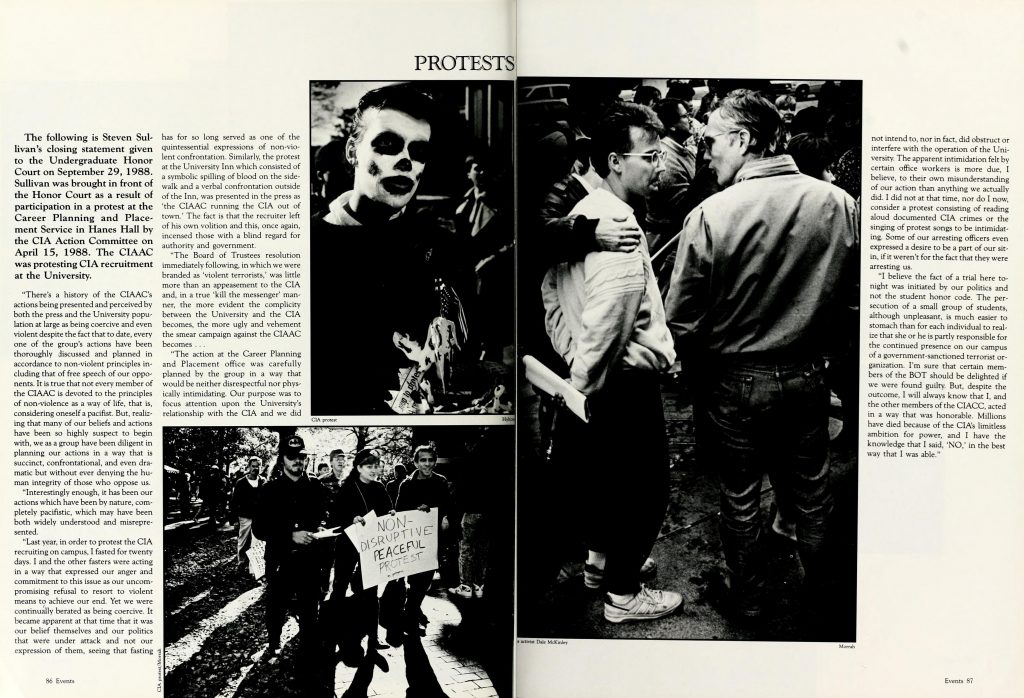
UNC-Chapel Hill, 1989, Central Intelligence Agency (CIA)
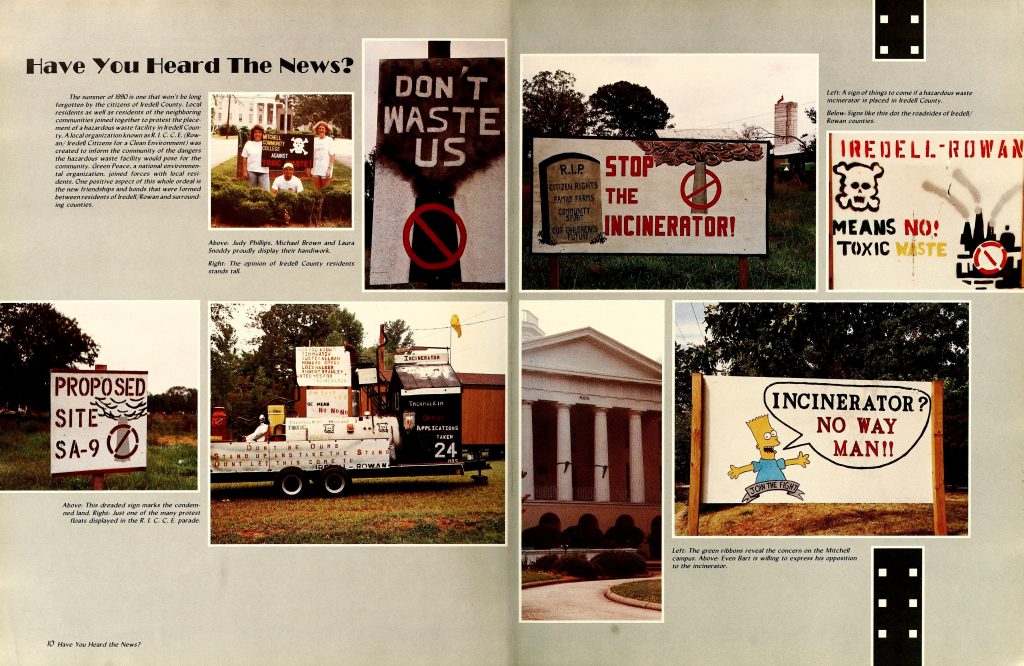
Mitchell Community College, 1990-1991, Hazardous Waste and Environmental Pollution
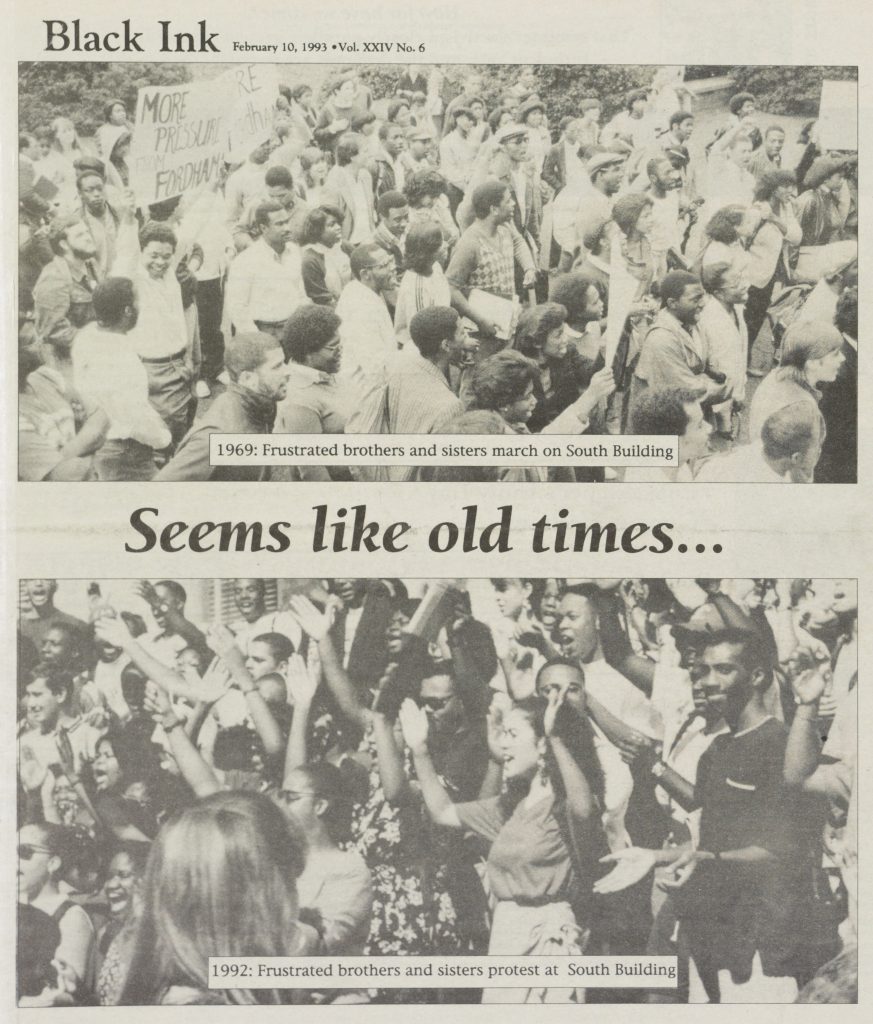
UNC-Chapel Hill, 1993, Racism
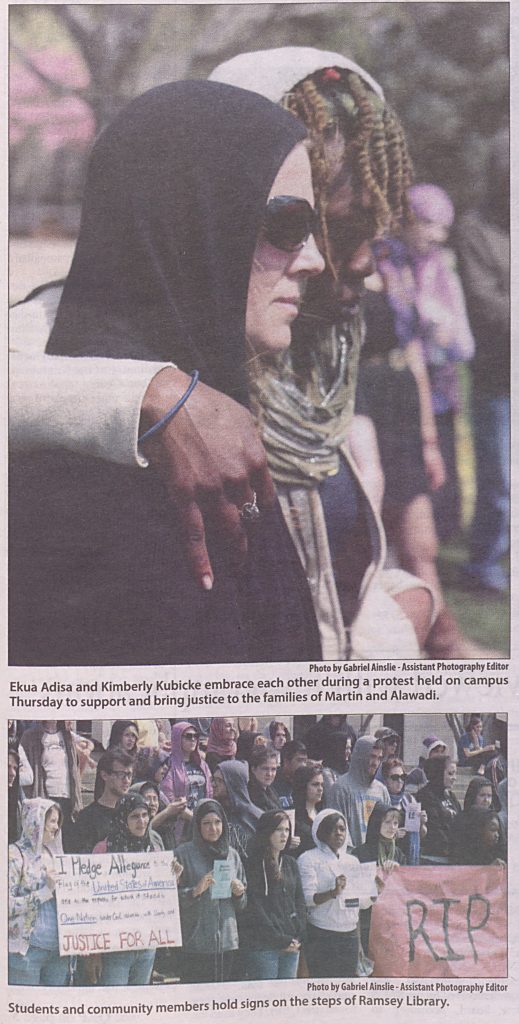
UNC-Asheville, 2012, Hate Crimes
The following microfilmed newspapers have been selected for digitization in 2016-2017. Around 70 reels were chosen from over 1,100 nominated reels, according to our Criteria for Selecting Newspapers to Digitize from Microfilm.
| Title |
Years |
Nominating Institution |
| Carolina Indian Voice (Pembroke, N.C.) |
1996-2005 |
UNC-Chapel Hill |
| The Cherokee Scout (Murphy, N.C.) |
1923-1943 |
Murphy Public Library |
| The Daily Advance (Elizabeth City, N.C.) |
1923-1927 |
Pasquotank County Public Library |
| Farmville Enterprise (Farmville, N.C.) |
1914-1941 |
Farmville Public Library |
| The Franklin Times (Louisburg, N.C.) |
1909-1924 |
Louisburg College |
| The Future Outlook (Greensboro, N.C.) |
1941-1972 |
UNC-Greensboro |
| The Roxboro Courier (Roxboro, N.C.) |
1922-1929 |
Person County Public Library |
| State Port Pilot (Southport, N.C.) |
1935-1949 |
Margaret and James Harper Jr. Library |
| Washington Daily News (Washington, N.C.) |
1909-1916 |
George H. and Laura E. Brown Library |
